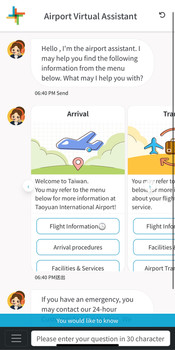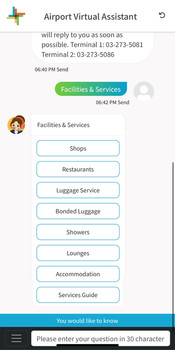Benchmarking AI Chatbots at the World’s Top 5 Airports
- Ravi Lal
- Oct 2, 2024
- 5 min read
Updated: Feb 25
Compare how leading airports like Geneva, Lyon, Frankfurt, Singapore, and Taiwan are using AI chatbots to enhance customer service and streamline operations. Learn about innovative features like biometric integration and real-time updates that improve passenger experiences.
As air travel continues to rebound post-pandemic, airports are increasingly relying on AI chatbots to enhance operational efficiency and improve customer experiences. Travelers today expect quick, accurate, and personalized services, and AI chatbots have emerged as an indispensable tool for meeting these demands. In this comparative analysis, we explore how five of the world’s leading airports—Geneva, Lyon, Frankfurt, Singapore, and Taiwan—are leveraging AI chatbots to streamline operations and improve customer satisfaction.
Geneva Airport (GVA)

User Experience & Design: Geneva Airport’s chatbot stands out with its simple, clean interface that uses button-based options for ease of navigation. Categories such as "Flight Info," "Parkings," and "Shops & Restaurants" are visually supported with icons and images, enhancing user engagement and accessibility.
Strength: Its ability to provide location-based suggestions, such as offering coffee shop options with images and terminal locations, is a standout feature, improving user satisfaction.
Opportunity for Improvement: While the chatbot provides comprehensive static information, it could improve by offering real-time updates for services such as shop opening hours or flight delays, ensuring travelers have the most up-to-date information at their fingertips.
Future Potential: Geneva could enhance its chatbot by integrating predictive text-based queries and proactive assistance (e.g., after suggesting coffee shops, asking, "Would you like directions?"). The chatbot would also benefit from expansion into additional channels like WhatsApp for more seamless user experiences.
Lyon Airport (LYS)

AI Innovation: Lyon Airport’s chatbot, Mona, leads in innovation with its integration of facial recognition technology, allowing for a personalized, seamless airport experience. In addition to providing essential information like parking, flight status, and accessibility options, the chatbot supports real-time booking modifications, further distinguishing it as a high-tech assistant.
Strength: The chatbot’s ability to adapt to user needs, offering specialized options such as assistance for passengers with reduced mobility, positions it as a leader in personalized service.
Opportunity for Improvement: While its functionality is extensive, Mona could improve by integrating dynamic, real-time updates on services like terminal crowd levels or dining options, similar to what is found in Geneva's offering.
Future Potential: Lyon's innovative use of biometric integration could be expanded to include services like biometric check-in or automated luggage tracking, bringing even greater convenience to travelers.
Frankfurt Airport (FRA)

Comprehensive Yet Simple: Frankfurt’s chatbot provides users with essential information such as flight status, dining recommendations, and parking bookings. Its intuitive structure—grouping services by categories like "Before Flight" and "On Airport"—makes it user-friendly and efficient.
Strength: Frankfurt’s chatbot excels in delivering fast, accurate responses for common queries, ensuring that travelers have the necessary information with minimal interaction.
Opportunity for Improvement: The chatbot lacks real-time, dynamic updates. Introducing live information on parking spaces, flight delays, or terminal congestion would significantly enhance its utility for passengers.
Future Potential: As with other leading airports, Frankfurt’s chatbot could benefit from introducing omnichannel capabilities, allowing users to interact via mobile apps, SMS, or other messaging platforms for a more seamless experience.
Singapore Changi Airport (SIN)

Engaging & Rewarding: Singapore Changi’s MAX chatbot stands out with a vibrant, user-friendly interface designed to offer personalized shopping and dining recommendations alongside practical travel information. Built on IBM Watson technology, it leverages AI to continually evolve and improve based on user interactions, making it a forward-thinking tool in customer engagement.
Strength: MAX offers a delightful, visually engaging experience, with large, colorful buttons and emojis that cater to a wide range of passengers. Its ability to provide exclusive benefits and shopping rewards, combined with personalized flight and airport services, makes it highly user-centric.
Opportunity for Improvement: While visually appealing and easy to use, MAX could further enhance user experience by incorporating real-time service updates, such as current security wait times or live operational hours for restaurants and shops.
Future Potential: By expanding its omnichannel reach to platforms like WhatsApp and adding more advanced features like proactive recommendations based on flight schedules or location, MAX can offer even more value to passengers navigating through one of the world’s busiest airports. Expanding its language support and enhancing AI-driven predictions could further boost its global appeal.
Taiwan Taoyuan Airport (TPE)

Convenient Design: The Taoyuan Airport Virtual Assistant offers travelers convenient access to essential services, such as passport control, dining options, lounges, and departure procedures. It features a structured interface that helps users quickly navigate through different service categories. The chatbot efficiently directs users to relevant information, often through links to the official airport website, making it particularly helpful for detailed inquiries like customs regulations or bonded luggage services.
Strength: The chatbot excels at categorizing information in an intuitive and organized manner. It is particularly useful for international travelers needing step-by-step guidance for airport procedures, such as passport control or lounge access.
Opportunity for Improvement: One key limitation is the chatbot’s lack of mobile optimization, which can hinder the experience for travelers using smartphones. Furthermore, the absence of real-time updates for flight statuses, security wait times, or dynamic facility hours reduces its effectiveness for time-sensitive queries.
Future Potential: Enhancing mobile optimization and incorporating real-time data would greatly improve the chatbot's functionality. Additionally, the introduction of conversational AI, allowing users to type queries more naturally, would create a more flexible and user-friendly experience for passengers.
Key Takeaways From our Review of Airport Chatbots
Across the five airports, certain trends stand out. Geneva and Lyon lead in personalization and innovation, with Geneva’s chatbot offering a rich visual interface and Lyon pushing the boundaries with facial recognition integration. Singapore and Frankfurt focus on efficient, task-based navigation via buttons, making them ideal for travelers seeking quick solutions. Taiwan’s stands out for task-specific efficiency, but like its competitors, would benefit from more real-time updates and conversational AI elements.

While these chatbots already provide essential services like parking, dining recommendations, and flight updates, their future success lies in real-time data integration and omnichannel accessibility. As the travel industry continues to evolve, airports that invest in AI-driven personalization and dynamic content delivery will be best positioned to meet the ever-increasing expectations of global travelers.
The AI chatbot landscape in airports is evolving rapidly, with each airport offering a unique blend of features to enhance passenger experiences. From Geneva’s visually intuitive design to Lyon’s cutting-edge biometric integration, airports are exploring new ways to make travel easier, faster, and more personalized. However, there remains ample room for growth, particularly in the areas of real-time data, omnichannel integration, and conversational AI. By addressing these areas, airports can further improve operational efficiency and customer satisfaction, ensuring a smoother journey for all.































Comments